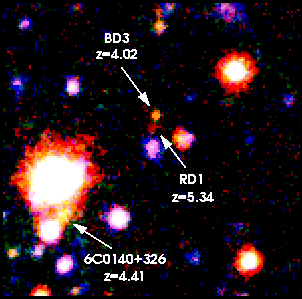RD1
| RD1 (0140+326 RD1) | |
|---|---|
|
RD1 as viewed by the W. M. Keck Observatory | |
| Observation data (J2000 epoch) | |
| Constellation | Triangulum |
| Right ascension | 01h 43m 42.8s |
| Declination | +32° 54′ 00.0″ |
| Redshift | 5.34[1] |
| Distance |
around 12.5 billion light-years (light travel distance)[2] ~26 billion light-years (present comoving distance)[2] |
RD1 or 0140+326 RD1 is a distant galaxy, it once held the title of most distant galaxy known.[3] RD1 was discovered in March 1998, and is at z = 5.34,[1] and was the first object found to exceed redshift 5.[4] It bested the previous recordholders, a pair of galaxies at z=4.92 lensed by the galaxy cluster CL 1358+62 (CL 1358+62 G1 & CL 1358+62 G2). It was the most distant object known to mankind for a few months in 1998, until BR1202-0725 LAE was discovered at z = 5.64.
Distance measurements
The "distance" of a far away galaxy depends on what distance measurement you use. With a redshift of 5.34,[1] light from this galaxy is estimated to have taken around 12.5 billion years to reach us.[2] But since this galaxy is receding from Earth, the present comoving distance is estimated to be around 26 billion light-years.[2]
References
- 1 2 3 arXiv, A Galaxy at z = 5.34 PDF (209 KB), 11 March 1998
- 1 2 3 4 Edward L. (Ned) Wright. "Cosmology Calculator I". Astronomy @ UCLA. Retrieved 2010-10-22.
- ↑ Astronomy Picture of the Day, A Baby Galaxy, March 24, 1998
- ↑ New York Times, Peering Back in Time, Astronomers Glimpse Galaxies Aborning, October 20, 1998
| Preceded by ClG 1358+62 G1+G2 |
Most distant galaxy 2011 — |
Succeeded by BR 1202-0725 LAE |
